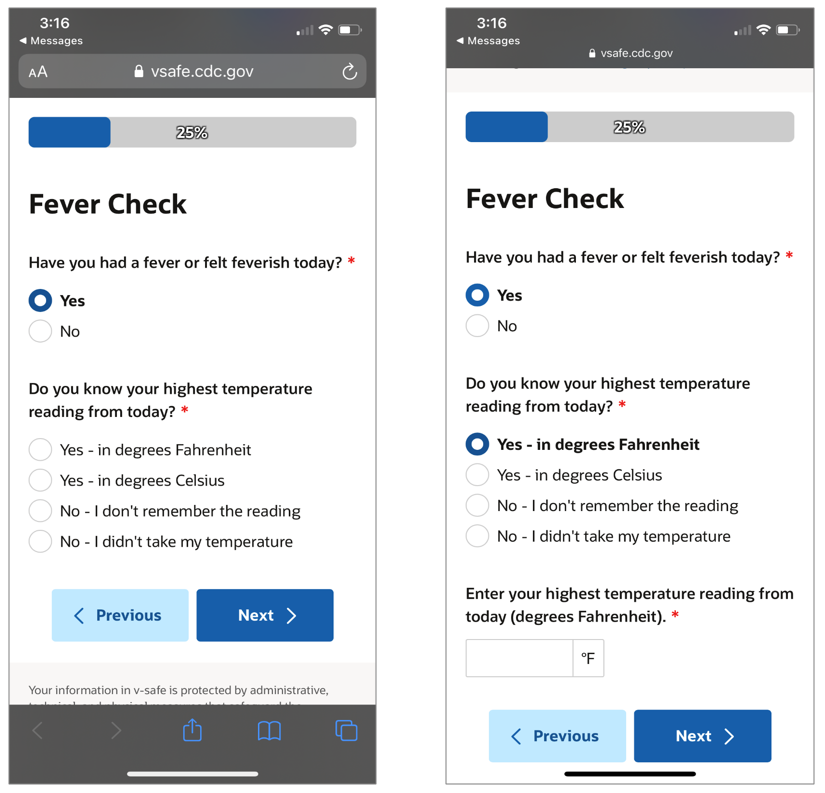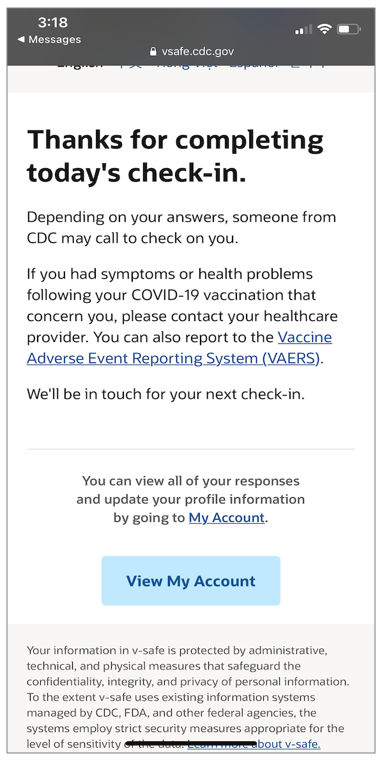
Three Lessons From the CDC’s V-Safe After Vaccination Health Checker
If you’re not getting the participation or engagement you want from your customer experience surveys, a jab in the arm might just give you some inspiration. The CDC has introduced a longitudinal survey, called the v-safe after vaccination health checker, for those who have received the COVID-19 vaccine. It’s a tool that delivers text messages and web surveys via participants’ smartphone, delivering personalized health check-ins after they have received the vaccine. The tool allows participants to tell the CDC about any symptoms they are experiencing, and depending on the response, may prompt a phone call from the CDC to find out if additional medical assistance is needed.
The study is a reminder that a survey isn’t only a way to collect data—It’s an opportunity to start a conversation, engage your audience, learn more about your customers, and build brand trust. Like the CDC, companies in every industry can create engaging surveys. It all starts with an effective survey design. With surveys designed to entice people to participation, you can collect better data, get better results, and ultimately, see better business outcomes.
Get More Value Out of Your Customer Satisfaction Tracker
Using v-safe as an example, here are three lessons on how to conduct an innovative customer experience survey that not only helps you collect better data, but shows customers you value their time and business.
1. Start a Conversation by Focusing on What Is Relevant to the Respondent
Has a customer representative ever told you that you will get a survey asking you to rate your experience? They may have even suggested that completing the survey helps them out? Chances are you have taken at least a few surveys like this, and the first question you see is a generalized scale question you have seen elsewhere. In this scenario, your priority may change from providing the best answers that you know will satisfy the conditions to complete the survey. You may decide to select neutral options because it doesn’t require significant thought, or you may decide to give the highest response because you believe it will help someone out at the company. Your actual experience becomes secondary to the goal of completing the survey.
In market research, this is known as satisficing. As you can see, satisficing works against the purpose of the survey by degrading the data. While this type of study can deliver critical business metrics, if you are interested in making your survey work for you on a higher level, there is a better way to get the meaningful data you need to move your business forward—you need to start a conversation.
Nowadays, relationships matter more than ever and surveys can be a tool to help you forge a relationship with the customers as well as gain valuable and actionable insight. If you want respondents to provide thoughtful answers to your survey, you first need to get them interested in what you have to say. That means asking relevant questions. For example, an automotive company that comes out with a new battery electric vehicle (BEV), could survey customers about their experiences for the first six months throughout different points of ownership.
Their first survey question might read: How does your vehicle feel to drive? If the answer is, “Great,” then the follow-up question should be: What felt great about it? Or, if it wasn’t a good experience, the follow-up question should be: “What’s the problem?” Or, “Have you seen a mechanic?”
Continue the survey and conversation by asking questions that sound natural. Not only will you keep your customers’ attention, but you’ll show that you are listening and that you’re working hard to improve their experience.
That’s where the CDC tracker gets it right. The first question is a conversation starter. After you register your vaccination on the CDC site, the tracker prompts you for your first health check-in. The survey greets you by name, starting off with the question, “How are you feeling today?” and provides three simple emoji-based answers: Good, Fair and Poor. It’s a question you’d expect from a friend or a caregiver, which makes people want to interact further.

Like v-safe, your opening questions should use conversational language and draw customers in to learn about their general feeling with your product, brand, or experience before you ask more in-depth questions.
2. Hold Your Survey Experience to the Same High Standards as the Rest of Your Customer Experience
Not only should surveys be used to start a conversation, but they should be viewed as an extension of your customer experience and brand relationship. Rather than sending out one survey into the void, it’s critical to make sure your survey is a great experience.
If respondents are happy with your product, explore that. If not, ask questions that help you discover respondent’s issues and how to solve them. As long as questions are fast, conversational and relevant for customers, they will enjoy the survey and provide quality answers. Ultimately, you want the survey experience to be held to the same high standards as all other parts of your customer experience. Here are a couple of ways to you may be able to improve your survey immediately:
- Ask simple questions to get better answers: In an effort to cut back survey time and length, some companies ask one complex question rather than two or three simpler questions, but the complex question can be difficult for your customers to answer—leading to frustrating and difficult-to-interpret results. The v-safe survey is a good example of how to streamline your survey questions. The survey asks simple, straightforward questions that can be answered quickly. It then displays additional questions only when relevant. Critically, it does not ask irrelevant or repetitive questions.For example, the v-safe survey asks if the participants feel feverish. If the answer is no, participants move on to the next screen. If yes, a relevant question displays: “Do you know your highest temperature reading for today?’ If yes again, participants are given a text box to type in their temperature. The program uses this technique throughout the survey, which quickly moves participants along.

- Take respondents down different paths to gather more insights: Another common practice is to send out a blanket survey with the same questions for every customer. While it may be simpler to send out one survey to everyone, you can collect more data if you ask different questions of different groups within the survey. If you have large sample sizes, you may explore branching paths to collect additional insights without increasing the survey length for individual respondents.
3. Follow Up and Respond to Build a Relationship
The v-safe program ensures an ongoing relationship with participants by sending out a survey every day in the first week after vaccination. It then checks in once a week for up to five weeks to ensure participants are healthy. Furthermore, the survey reminds participants to get their second shot, if relevant, and lets them know that someone may call to check on them depending on their answers. This shows participants that their input is important and generates immediate action.

If a second shot is needed, the tracker sends a reminder for a new 6-week check-in process, allowing participants to share their experience just as they did with the first round. Finally, the tracker sends check-ins three, six and 12 months after the final vaccine to find out about any longer-term issues people might be facing.
V-safe is just one example of how you can deepen relationships and stay connected with customers by providing them with high-value, frequent interactions built around their experiences. Let’s say you provide a speaker that connects via WiFi. When the customer first receives the speaker, you can survey them around the setup experience. Once they’ve had a chance to use the speaker for a few weeks, ask them about the quality—“How does it sound?” and “Have they had an issues?”
By checking in with customers over time, you can build trust and loyalty, showing them that you value them beyond the sale.
Remember, not all studies require a longitudinal approach. In those instances, think about sending a follow-up thank-you note a few months later, perhaps with some details about how the survey helped improve their product. It’s also important to follow up with those who have indicated that they would like you to contact them. Be careful not to imply that you will contact them if you have no intention to do so.
Strategic Summary
Customers are giving up valuable time to respond to your survey, so you should design surveys that work for them, and encourage them to give their best answers. Surveys are tools that not only help you collect data, but also strengthen the customer relationship with your brand.
Well-designed surveys lead to higher quality data, which then lead to better results, and ultimately better business decisions. At Escalent, we’re giving clients bold, innovative ways to design their surveys, and we can help you design the best possible survey for your customers and organization.
If you want to learn how you can get more ROI from your customer experience surveys through more thoughtful survey design, send us a note.








